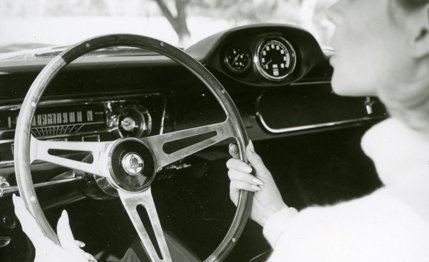Inside, the Mustang GT 350 is practically a standard Mustang. A wood-rimmed steering wheel, which has a Cobra emblem at the hub, is added, and there is a small instrument “pod” perched over the center of the dashboard with an oil-pressure gauge and a tachometer (red-lined at 6500 rpm). The front seats are stock Ford, but very business-like, 3-inch wide, Air Force-type seat belts are fitted instead of the Brooks-Brothers-tie-with-a-buckle belts seen in most passenger cars. Passenger room, up front, is the same as in any Mustang, except that the steering wheel dish (or more accurately, the lack of it) has moved the wheel rim forward and the driver may adopt the classic arms-extended driving position. He will pay for this advantage with a wheel rim that is a bit near the knees, but we think everyone will agree that is better than having it scuffing against one’s navel—as is the case in the standard Mustang.
Passenger space in the rear has been eliminated altogether. The rear seats are removed and the area covered by a molded fiberglass fitting that provides a flat shelf for mounting the spare tire—horizontally—with some space left over for stowing helmet bags and the like.
|
|
Underneath this shelf, slots where cut in the sheet metal of the floor pan. The aforementioned torque control arms poke through these slots on their way to their forward pivot points. To prevent water from sloshing into the interior through these slots, a patch of rubber was slipped over the arms and riveted around the clearance slot. A grand arrangement but for the fact that the vertical movements of the arms gradually tear away at the rubber, allowing not only water, but—due to the proximity of the ends of the tail pipes—exhaust gasses to seep into the interior. This is potentially very dangerous, and we churlishly suggested to the project’s engineers that they supply a canary in a cage with each car. Welsh miners tell us that a canary will keel over at the first whiff of coal damp, and presumably the same fate would befall the bird with carbon monoxide—thus warning the driver to bail out while there’s still time. The engineers promised that subsequent GT 350s (our test car was the twelfth built) would have the slots, arms and forward pivots enclosed in a sealed box. We sure hope it works.
View Photos
View Photos


Leave a Reply